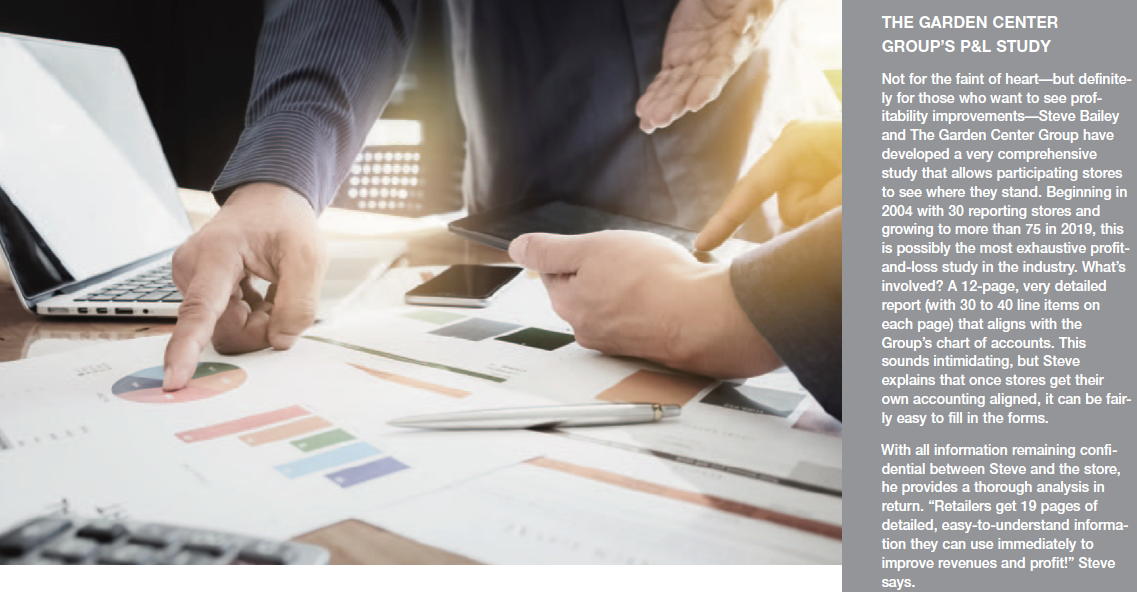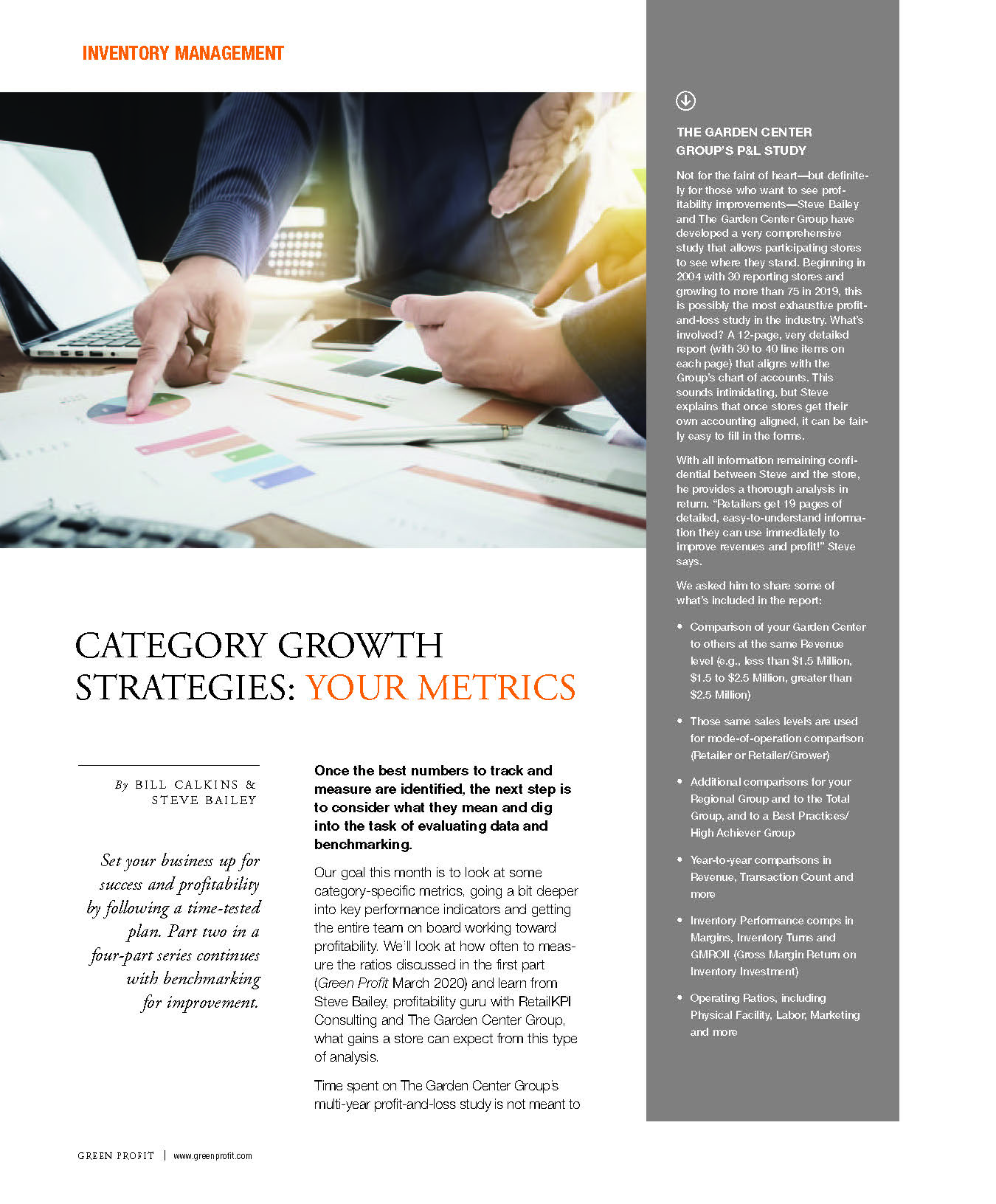Category Growth Strategies: Your Metrics (part 2)
By Steve Bailey and Bill Calkins
The following is the Part 2 of the series... Category Growth Strategies: Your Metrics. This was originally published in the April edition of greenPROFIT magazine and can be seen HERE. If you missed the Part 1, you can see it HERE.
Earlier this year, Ball Publishing's Bill Calkins approached Steve Bailey about co-writing a series of articles that could lead garden centers through the basics of analyzing category performance and some of the measurements developed for The Garden Center Group Clients through the Annual P&L Study. The result is a series of four articles published in Ball's GreenPROFIT magazine in this spring.
If you have been active in The Group at least a few years you have already been introduced to  the details in this series but it is always great to have notes and a refresher article to recap what you are already working on here in The Group.
the details in this series but it is always great to have notes and a refresher article to recap what you are already working on here in The Group.
You may also download a PDF of this article HERE.
A special THANK YOU to both Steve Bailey and Bill Calkins for their efforts in developing this series and of course every one of the centers who have been a active part of The Garden Center Group since 2004 who have helped develop The Group's benchmarking programs!
This is part 2 in a four-part series continues with benchmarking for improvement. If you missed the Part 1, you can see it HERE.
Once the best numbers to track and measure are identified, the next step is to consider what they mean and dig into the task of evaluating data and benchmarking.
Our goal this month is to look at some category-specific metrics, going a bit deeper into key performance indicators and getting the entire team on board working toward profitability. We’ll look at how often to measure the ratios discussed in the first part (Green Profit March 2020) and learn from Steve Bailey, profitability guru with RetailKPI Consulting and The Garden Center Group, what gains a store can expect from this type of analysis.
Time spent on The Garden Center Group’s multi-year profit-and-loss study is not meant to be a sales pitch to join The Group—although benchmarking against peers can be very transformative—but instead is a way to drive home the importance of external benchmarking and some of the most important things participating retailers have learned. Steve says a profit-and-loss study is the benchmark that actually allows stores to see where they stand.
Appetite Matters
Before starting work on this article series with Steve, a question we wanted to discuss was the appetite retailers have for taking on this kind of project. Do owners and managers really want to start collecting and interpreting this kind of data? And what’s that trigger that causes someone to give Steve or The Garden Center Group a call to begin the process? Steve says it has to be driven by self-motivation and a hunger to improve. What he usually finds is when performance begins to improve, his clients want to do more and more. “It’s a domino effect,” he says.
And it’s a challenging process once goals have been established. “A goal of 10% profitability is aggressive,” Steve says. “But I’VE SEEN some Group members at 17% or even 22%.”
For many, seeing results creates a domino effect leading to more attention to the key metrics. The goal is to keep doing better as long as everyone benefits, he adds.
Learning Curve
Taking the time to collect the right information and use it to improve categories can be a challenging process. Steve finds that it often depends on the numbers an operation is trying to begin analyzing. Margin dollars and percentage can be the easiest and provide the most effective building blocks to developing a formal process. Steve explains he frequently must coax someone new through the process because it can be challenging to understand that when working to improve category growth, margins might have to be sacrificed to increase turns.
“For some, it’s instant comprehension, but for others it can take two or three years,” he explains. “The more you talk and review the numbers, the easier it gets.”
What he always tries to avoid is creating “margin monsters” who are only concerned with this metric.
“If they have a bad buy, they won’t let that margin go and get rid of bad inventory,” he says. “What’s better? Turns or margins?” Steve says the answer is turns.
When to Work
“I recommend a weekly store meeting to discuss margin and revenue,” Steve says. “Then, once a month focus on margin and revenue goals.”
The weekly meetings should be about 30 minutes and the monthly meetings might be an hour. Annually, your team should meet to dive deep, and assess turns and GMROII within each category because these metrics are measured on a 12-month basis. These meetings could last as long as eight hours, but are certainly worth that kind of time. Steve suggests devising a step-by-step, incremental approach and then creating a plan. This will help flatten out the learning curve for everyone involved.
P&L Benchmarking Leads to More KPIs
Steve says the reason to develop a clear profit-and-loss report, benchmarked against peers, is to not only assess your own performance, but also to allow for additional key performance indicators to rise to the top.
“In The Garden Center Group’s P&L Study, we start with margin dollars and cost of goods sold (COGS) and then start measuring gross margin and return on labor,” he explains. “And it is not based on revenue, it’s based on margin.”
Why? Consider this: Your store could have $1,000,000 in revenue, but if only $400,000 is realized due to margins, that’s a big difference than having $550,000 in margin dollars. That can translate to an additional $100,000 or more on the bottom line.
Steve likes to look at efficiency ratios based on three important metrics: GMROII (gross margin return on inventory investment), which we detailed in the first part of this series; GMROL (gross margin return on labor) and GMROF (gross margin return on footage). GMROL is calculated by dividing margin dollars by total hours of labor and GMROF uses the equation margin dollars divided by square footage (by category).
“Put all of these numbers together and say ‘WOW, this is how I can design a profitable garden center,’” Steve says. Labor efficiency, inventory efficiency and square footage efficiency (based on margin dollars) are the KPIs to measure.
Share and Share Alike
Once you, as an owner or manager, have started collecting and analyzing the numbers, benchmarking internally and externally, and seeing profit improvements, don’t benefit yourself over the team.
“We are a giving industry and that’s one of the reasons your team members feel your store is a great place to work,” Steve reminds. “When a garden center is profitable, it should be an even better place to work.”
Your entire crew is required to grow profits like we’ve discussed in the past two parts of this series, and when everyone is working in unison—with clear goals and metrics—be sure to reward everyone. This is how to build morale and ensure the hard work continues.
Learn more about The Group at www.thegardencentergroup.com. And if you’re interested in business-specific consulting with Steve Bailey and his company RetailKPI Consulting, you can find more information at www.thegardencentergroup.com/steve-bailey-intro.
What’s Next?
The next part in this series will dig deep into category specifics. Since some categories have shown higher and lower potential for success, we’ll get more specific by looking at the key category drivers in most organizations. Success with perennials is far different than success with statuary and how each should be approached is just as different. Questions we’ll address include: Is relying on dating a good thing or not? What are the benefits of buying less, more often? Should garden centers double down on categories that are performing and what does this look like. Stay tuned!
Ready for Part 3? You can see it HERE.
